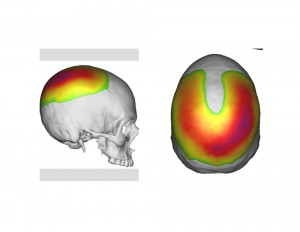Background: Aesthetic skull augmentation can be done for a wide variety of deficient skull shape concerns. Changes can be made in skull height, skull width and frontal and posterior skull projection. In rare cases and with the use of a first stage scalp tissue expander, the entire skull can be augmented through a circumferential effect. Such head size increases are largely achieved through a bone augmentative effect.
One aesthetic head size change request is that of ‘head widening’. This can mean a variety of head shape changes, all of which refers to some vertical level of the sides of the head. One patient request is to widen the upper sides of the head. This is the transition area between the top of the head and the sides of the head, in essence the sloped area from the sagittal ridge (middle of the head from front to back) down into the upper temporal region across the bony temporal line. Such a skull width increase is largely bony (sagittal ridge to anterior temporal line) but is also partially soft tissue based. (inferior to bony temporal line)
While a variety of skull augmentation materials have been used over the years to help achieve these changes, the recent use of 3D CT scanning and silicone implant design has made the procedure more reliable and effective. When designing such a skull implant to widen the upper half of the skull, the location and thickness of the temporal muscle must be taken into consideration. To do on a 3D CT scan the temporalis muscle must be painted’ onto simulate where it is since this is a bone scan.

Under general anesthesia, the custom skull implant was placed through an 8 cm scalp incision. Because the implant was reasonably thin it could be folded and inserted through a length of an incision that was smaller than the width of the implant.
His postoperative results showed the desired change immediately on the operative table as would be expected. Recovery is very minimal with this type of smaller skull implant. While there is some swelling it is ‘hidden’ in the hair and not visible to others. The skull change with this type of implant is modest but appreciable. This fitted in with the patient’s aesthetic head shape desires and amount of commitment needed to do so.
The use of custom designed skull implants today allows for making even subtle head shape changes is a predictable, safe and minimal risk method.
Highlights:
1) A head widening effect can be most reliably achieved with a custom made skull implant.
2) The desired dimensions of a head widening skull implant are made from a 3D CT scan of the patient.
3) If the skull implant is not too thick, it can be inserted through a relatively small scalp incision.
Dr. Barry Eppley
Indianapolis, Indiana



